BY DAVE CONSTANTIN
Of all the reasons you might have for wanting to build your own drum set, the most important one has nothing to do with being practical. It has to do with desire. Because the thing about building your first kit—the thing I learned, anyway—is that it really needs to be a labor of love. A project with so many finicky little pieces and irreversible steps will always take longer and be more fraught with setbacks than you want to believe at the outset.
That being said, after the struggle is over and you’re able to sit back and take a long, loving look at this fully formed instrument you just brought into the world, you’ll forget all about that other stuff and simply bask in the warm glow of satisfaction that comes with seeing something like this through—preferably while wailing away on it with sticks.
So just to be clear: Building your own drum set from scratch is 100 percent worth the effort. Just don’t expect the wrong kind of reward. If your motivation is merely to save money, for instance, the justification for this project is going to be hard to square, especially if you believe your time is worth anything at all.
As any drummer knows, we live in an age of plenty when it comes to gear, and it’s scary-easy to go online right now and buy a perfectly playable, brand-new, entry-level drum set for a few hundred bucks.
Sure, you could go the DIY route with only the cheapest materials available and quickly slap together your own version of one of those off-brand student kits. But even if you could do it cheaper (doubtful), all you’ll have to show for your considerable effort is, well, a crappy drum set. And there are enough of those in the world already.
If you’re going to do it, do it right. Aim as high as your budget will allow and build the kit you want. If you succeed, you’ll have something that could very well rival a high-end offering from a top drum manufacturer. If you fall short, you’ll still end up with something you can be genuinely proud of, even with some ruined shells or other catastrophes factored in.
Granted, the chances of you slam-dunking this thing on your first try and rivaling the decades of experience hard-earned by those who make their living building drums is fairly slim. But you’re guaranteed to learn a thing or two, and maybe even enjoy it. Who knows, this could trigger a waterfall effect and before you know it, you’ll find your name situated among the titans of drum making. One step at a time, though.
Laying the groundwork The options for this kind of build, of course, are limitless. That’s what makes it so exciting. But you’ll have to work out that 57-piece tubular circus you’re envisioning on your own time.
This is a practical tutorial on how to build an understated yet elegant 5-piece drum set that requires minimal tooling and materials and no particularly esoteric equipment, skills, or fancy shop space—I completed the entire project, start to finish, on the balcony and in the living room of my apartment using a fair amount of homemade jigs and setups to make up for any lack of specialty tools.
There obviously isn’t enough room in one article to get extraordinarily deep into the specifics of each part of the process, but this should give you a good indication of what’s involved, with visual references for each step of the process. Also, the steps outlined here are foundational, so you’ll be able to use the concepts and techniques to build many different types of kits.
The kit I’ve built consists of components graciously donated by the companies involved to showcase what’s possible. The maple shells that make up the main body of the kit are from Keller—a formulation called Magnum that features the same high-grade maple and assembly technology as Keller’s VSS shells, but with plies that are about 40 percent thicker.
The main snare is a solid-ply walnut shell from Vaughncraft, a company long known for outstanding solid-shell drums. The Keller shells received a curly-maple veneer expertly done by Eric Sooy, owner of Drum Foundry and Black Swamp Percussion. The hardware came from Drum Factory Direct, a one-stop-shop for pretty much any drum components you can imagine. And Remo supplied the heads. The rest of the finishing materials and tools were purchased separately.
As for less tangible costs, if I were billing for time on this project, I’d estimate about 20 hours, although in reality I completed it over the course of weeks in bite-size chunks of time snatched away from a busy schedule—the way any hobbyist most likely would. It’s also difficult to put a hard figure on the research, planning, setup, mistake correction, etc., that are built into this kind of undertaking. But just know that it’s not going to come together in a weekend.
One final note: There are countless ways to screw this thing up, both big and small.
Failing to double-check a single misplaced lug mark is enough to tank a whole shell (unless you’re going for the Swiss-cheese look). So take your time and think things through, consult any and all available resources, stay flexible with your expectations, and before you know it you’ll be rocking out on your very own homespun drum set built to your specs with your own two hands.
So let’s get started.
How To Build Your Own Drum set
THE BUILD
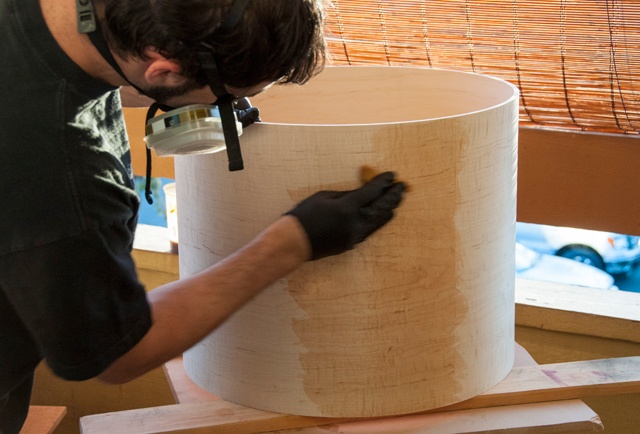
1.
Nothing beats the ease of a wipe-on finish. But before the final varnish could be applied, I utilized a popular technique for figured wood known as “popping the grain.” The idea is to use a dark color to highlight the end-grain of the figuring and give it subtle distinction from the surrounding lighter wood. Under the final finish, the wood takes on a 3-dimensional quality, or “chatoyance,” that can be dramatic.
I used a TransTint aniline dye for this, Dark Vintage Maple, which you can order online or find at specific woodworking stores like Woodcraft. To do this, you simply wipe on a diluted application of dye to shells that you’ve sanded with no finer than 320-grit sandpaper (any finer and you’ll close the pores and prevent the finish from absorbing into the surface properly).
After some trial and error with different colors and dye ratios with a scrap piece of veneer that I’d glued to a board and outlined with a simple test grid using thin strips of painter’s tape, I went with a ratio of two drops of dye to 1 oz. of denatured alcohol. I was warned this process might interfere with the glue bond of the veneer, but after testing on scrap and on the bottom of the bass drum (pictured above), I felt confident it would be fine. It was.
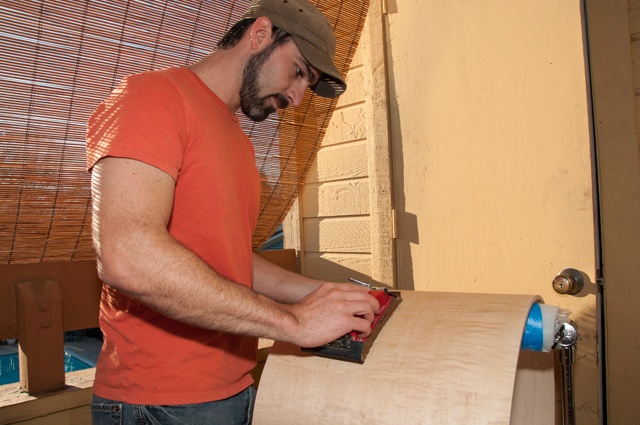
2.
After the dye dries, sand back the entire shell with 220-grit sandpaper using a padded sanding block. The dye will have penetrated deeper into the end-grain figuring, leaving a subtle distinction with the surrounding “flat” areas of bare wood that will really show up beautifully under the topcoat.
Here I’m working on one of two key support jigs suggested in the excellent tutorial DVD Guerrilla Drum Making, which offers a wealth of practical tips that I pulled from generously for this project. This jig is simply a cymbal boom stand angled at 90 degrees and wrapped with padding. It proved immensely useful throughout the process.
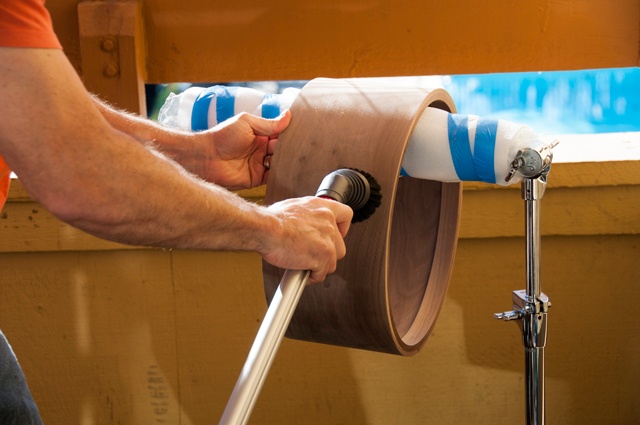
3.
After any sanding operation, thoroughly vacuum out the dust or it will show up as light specks underneath the finish.
PRO TIP: When sanding or finishing, always go in the direction of the grain.
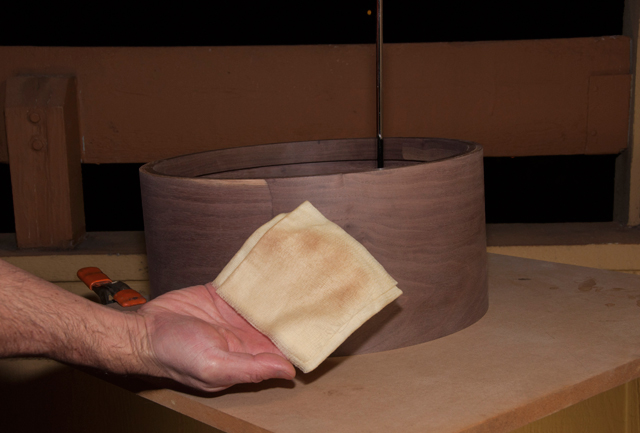
4.
Follow that up with a good wipe down with tack cloth. You can see how much dust remained lodged in the pores even after vacuuming.
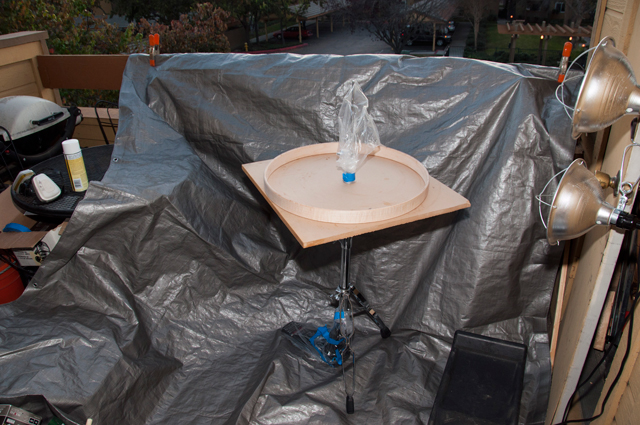

5. & 6.
The next step is to apply a seal coat—in this case a very thin layer of rattle-can clear shellac, which you can pick up at any hardware store. This will provide a barrier between the wood and finish. The beauty of shellac is that it’s non-toxic (though still not something you want in your lungs, thus the respirator) and compatible with nearly any finish you want to apply over it.
This is the makeshift “spray booth” I set up on my deck to catch overspray, along with the other support jig suggested in Guerrilla Drum Making: a hi-hat stand with a piece of 0.75″-thick MDF serving as a lazy Susan of sorts. This jig proved to be another lifesaver when it came to finishing, drilling, and applying hardware later.
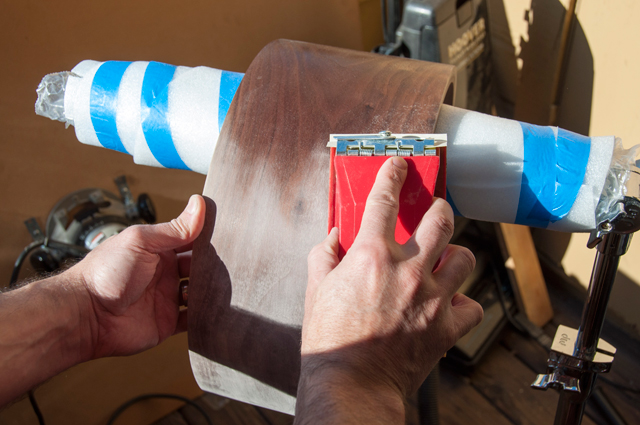
7.
Scuff sand the shellac after it dries with 220-grit, just enough to smooth it out but not cut through it.
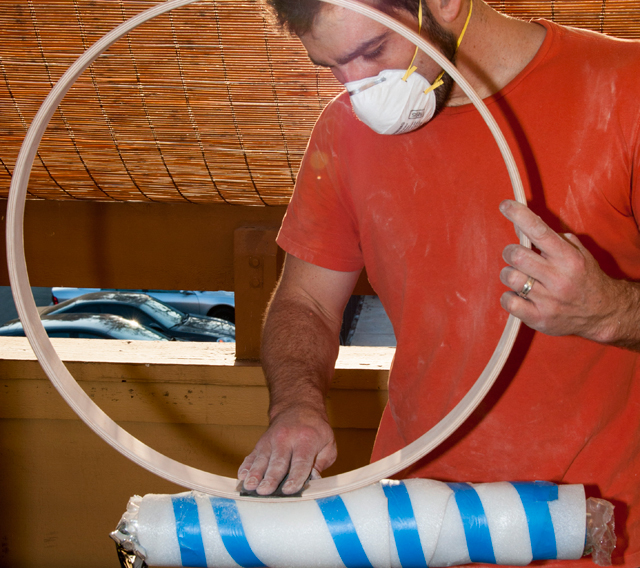
8.
The cymbal-stand jig in action during the scuff sanding of the hoops. Note the dust mask. Safety first!
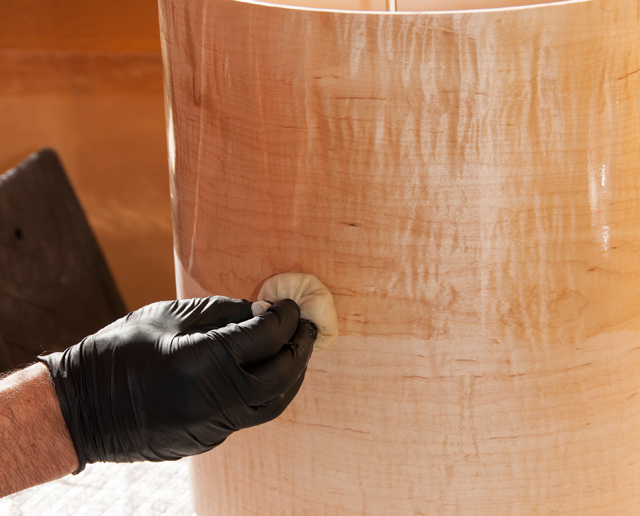
9.
I wanted to use the easiest, most-durable, and most attractive finish available. And while the finishing world is dense with options that meet one or more of those criteria, very few can boast all three. General Finishes Arm-R-Seal can. A combination of oil and polyurethane, it comes in Satin, Semi-Gloss, and Gloss varieties. I opted for the Semi-Gloss.
I applied the Arm-R-Seal using a “French-polish” rag—just a few layers of square T-shirt fabric balled up and held together with a rubber band. I simply held the applicator still and rotated the lazy Susan hi-hat stand, dipping the applicator back in the oil when the run started to feel tacky.
The biggest challenge with this finish is not letting it tack up too much before you’ve finished. It’s very hard to go back and blend once it starts to set up, which happens in just a few minutes. But if you’re careful and do very thin coats, it’s a pretty painless procedure.
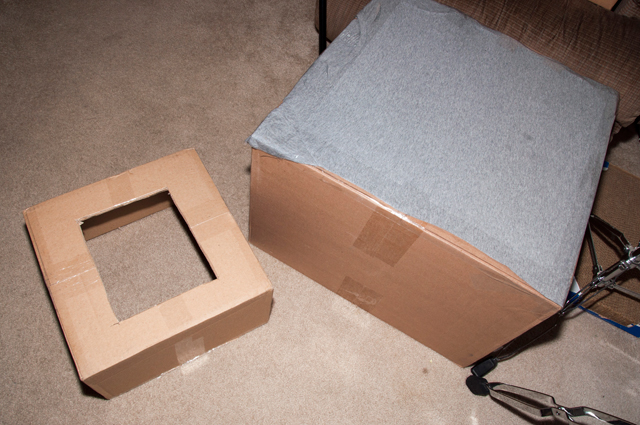
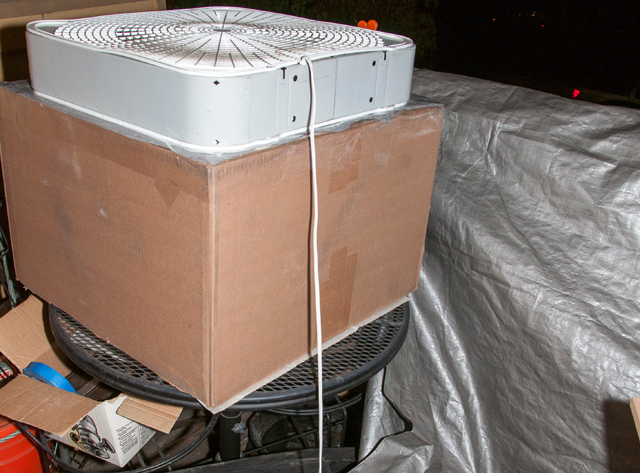
10a. & 10b.
The other challenge with any type of finish you’re attempting in an uncontrolled environment—and this goes double for wipe-on oil finishes like this one that take 6—12 hours to dry—is preventing dust and debris from finding their way to it like moths to a flame. I came up with a solution that proved very effective.
I used the boxes the shells came in, cut out a square on top, and stretched a double layer of T-shirt material over the hole, secured with packing tape. Immediately after applying a layer of finish to the shells, I placed them under the boxes and put over-turned fans on top to blow positive pressure through the T-shirt “filter” into the box. This had the dual effect of ensuring no dust could find it’s way in and cutting down the drying time significantly.
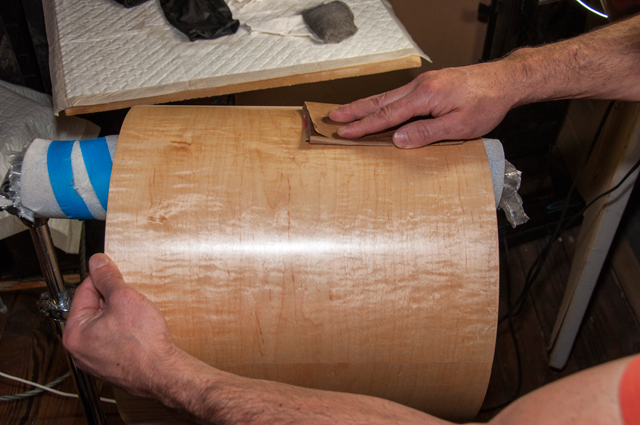
11.
Superfine sanding between coats is essential. The directions on the Arm-R-Seal can recommend 0000 steel wool, but to avoid the annoying shedding fibers and added cost of that approach, you can simply use a piece of folded up paper bag (of the standard supermarket variety). It’s equivalent to about 800-grit sandpaper and will get the job done just fine with a little elbow grease.
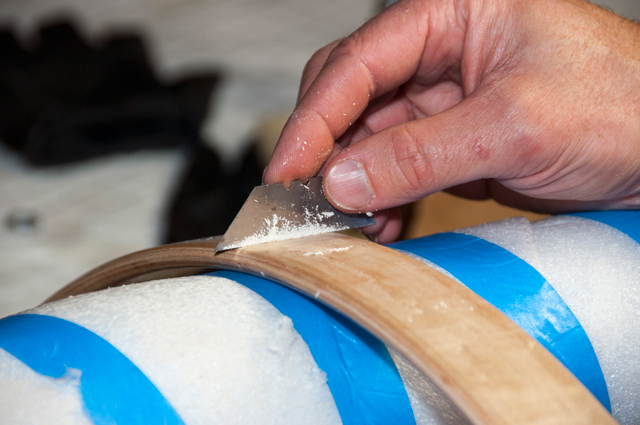
12.
Use a razor blade to carefully shave down runs between coats, which seem particularly hard to avoid on the bass drum hoops.

13a. & 13b.
To make it easy, I opted for double 45-degree bearing edges on all the drums, using a brand-new router bit to ensure the cleanest possible cut. Since I don’t own a router table, I made one out of a piece of 0.75″-thick MDF with a hole cut out of the center.
MDF is inherently flat and stable, and as long as you set it on something equally flat and stable that will support the weight of you pushing down on the shell during the cutting process without warping or slipping, you should be golden. Here I’m using two tire ramps for the car turned on their side because that’s what I had available and they worked great.
With no easy way to screw this particular router base down, I had to get creative (a magical opportunity for the industrious DIYer). I used metal plumber’s tape looped over the handles and screwed to the underside of the table. (That flexible metal tape has gotten me out of more jams than I can count.) Lag bolts allowed me to tighten up the slack and cinch the router base tight to the table. It never budged.
13c.
Everything in position and ready for cutting. The ramps offered just enough clearance for the router when I turned the table over, and the low height allowed me to get over the top of the shell easier than if it was at standard waist height. Moving the ramps in close to the router ensured a solid, flat base at the most important part of the table – the area directly around the cutter-head.

14a.
Once you’ve got your setup carefully calibrated, the actual cutting part is a breeze. You can use the “steering wheel” approach, which I’m using in this photo, or move the whole shell around the blade, using a lot more of the table real estate. I’ve seen a lot of debate over which is better, but as long as you keep going around until you don’t hear any more cutting, you should be good.

14b.
On the left side of the router table I set up the “leveling station,” which consists of pieces of sticky-backed 220-grit sandpaper used to ensure the bearing bearing edge is as flat as possible.

14c.
Blue chalk makes it easy to see the high points you still need to sand down once you start flattening edges.




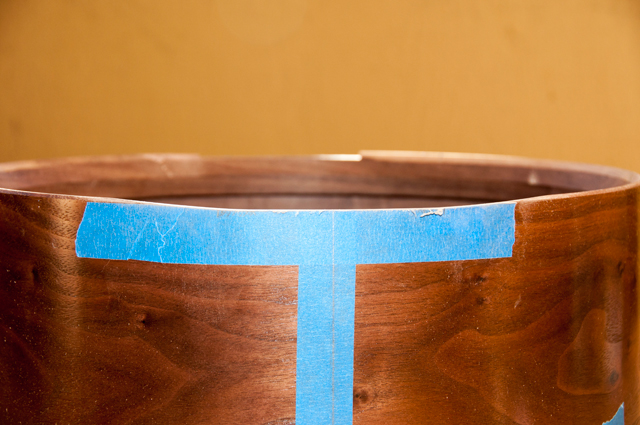
15a.–15e.
After a fair amount of deliberation and research, I decided to cut the snare beds for both the main and side snare at 0.125″ deep and just wide enough to span the lugs on either side. I hogged out most of the material using a straight bit on the router table, then used a sanding block to ease the transition.
A 1″–1.25″ taper seemed to offer a gradual enough transition to get all the wrinkles out of the head and not leave a sharp corner that could puncture the film. This is somewhat delicate work that takes a good amount of feel and attention. Don’t rush it!

16.
The main snare drum outfitted with tape for laying out the hardware. I opted to put the throw-off on the seams of both snare drums, and ran the seam in line with one set of lugs on the other drums. If you’re anything like me, these minor aesthetic choices can be the kind of thing that keeps you up at night.

17.
To lay out the hardware, place a head and hoop on top of the drum, tape them down, then hang the tension screws down through the holes. Slide all the tension rods to the far left or right of the hole and mark a line on tape where they fall on the shell, being careful to hold the pen or pencil at the same angle for each marking.

17a.
Extend the line with a combination square.

17b.
Use a tape “bridge” in the middle of the longer shells to extend the line to the opposite side, which will aid in symmetrical layout whether you’re using in-line or staggered lugs on your shells.


18. & 19.
To figure out proper lug-height placement, hang each tension rod from the hoop and thread it into the lug by two full turns. Wherever the top screw hole on the lug sits on the line is where you can make your first mark. In the case of these mini tube lugs, with no swivel nut and two 0.25″ zero-clearance holes per lug offering no margin for error, perfect alignment is essential.
To ensure that, I filed down two sawed-off screws to sharp points and used them as center-point punches in the lug screw holes, tapping marks into the shell with a dead-blow to indicate exactly where I’d need to drill. This also sped up the layout process considerably, saving me from measuring 56 separate times for every single lug, hoping each time I’m not a fraction of an inch off on any measurement.

20.
Deepen each indentation mark with a spring punch to set it definitively in the shell and give the drill bit purchase.

21.
Be sure to hold the bit perfectly perpendicular to the shell when drilling out the holes.

22.
The hi-hat table works great for assembly as well. Black nylon gaskets go between the shell and lug at every connection point. They work not just as physical buffers, but also as spacers to keep the tension rods at the right distance. Plus, they’re a nice aesthetic touch.

23.
The inline lug placement created a bit of a problem on the 6″-deep side snare, where I had to move the lugs closer to each edge by a fraction of an inch to keep them from butting into each other. But one of the washers in each grouping still had to be trimmed back to avoid overlapping. Since it’s hidden under a coated head I wasn’t too concerned with the appearance.
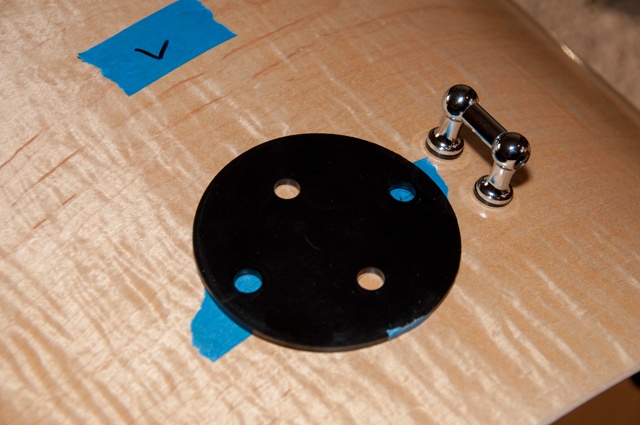
24.
Align the bass drum legs by eye, being sure they’re not fully extended or retracted but are going to hold the front edge of the bass drum up by 0.5″ or so. Then use the gasket as a template to ensure perfect alignment and screw placement.
PRO TIP: I used medium-strength thread-locking compound on all the components I deemed “permanent”—namely the screws for the bass drum legs and snare throw-offs, and the threads on the air vent grommets (one per drum, placed directly between lugs on the lower third of each shell).
https://drummagazine.com/meet-your-maker-nordic-shells/
